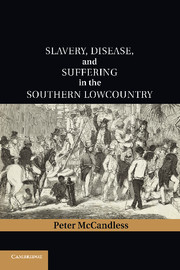Book contents
- Frontmatter
- Contents
- List of Figures
- List of Maps
- Preface
- Acknowledgments
- List of Abbreviations Used in Notes
- MAP 1 The Lowcountry, Charleston, and the Caribbean region
- MAP 2 The South Carolina lowcountry, showing Anglican parishes and slave proportion of population, c. 1760s
- MAP 3 Charleston Harbor, based on a British map, c. 1780
- MAP 4 The Revolutionary War in the South
- PART I TALK ABOUT SUFFERING
- 1 Rhetoric and Reality
- 2 From Paradise to Hospital
- 3 “A Scene of Diseases”
- 4 Wooden Horse
- 5 Revolutionary Fever
- 6 Strangers' Disease
- 7 “A Merciful Provision of the Creator”
- PART II COMBATING PESTILENCE
- Bibliography
- Index
- References
6 - Strangers' Disease
Published online by Cambridge University Press: 03 May 2011
- Frontmatter
- Contents
- List of Figures
- List of Maps
- Preface
- Acknowledgments
- List of Abbreviations Used in Notes
- MAP 1 The Lowcountry, Charleston, and the Caribbean region
- MAP 2 The South Carolina lowcountry, showing Anglican parishes and slave proportion of population, c. 1760s
- MAP 3 Charleston Harbor, based on a British map, c. 1780
- MAP 4 The Revolutionary War in the South
- PART I TALK ABOUT SUFFERING
- 1 Rhetoric and Reality
- 2 From Paradise to Hospital
- 3 “A Scene of Diseases”
- 4 Wooden Horse
- 5 Revolutionary Fever
- 6 Strangers' Disease
- 7 “A Merciful Provision of the Creator”
- PART II COMBATING PESTILENCE
- Bibliography
- Index
- References
Summary
Our knowledge of this fever is very limited. It appears that there is a certain something in the air of Charleston that is comparatively harmless to the inhabitant, but the source of disease and death to the stranger. What is that something?
David Ramsay, September 1799At Madame D'Orvals they have sent to the hospital. The poor Irish woman they say with the yellow fever – she waited on them; perhaps she will die there by strangers buried and by strangers mourned.
Vanderhorst diary entry, September 1838“CHARLESTON'S YELLOW FEVER”
“The mortality is beyond anything known for many years. There are very few strangers … escaping. Those who did not make a seasonable flight have found an untimely grave in a land which they had visited for wealth or pleasure.” The author of these words, Joshua Whitridge, was describing an epidemic of yellow fever in Charleston in 1817. Whitridge was himself a stranger, a doctor who had recently migrated from New England, perhaps lured like others by the fact that the city had been virtually free of the fever since 1807. He had just recovered from the disease and was treating its victims with great success, or so he claimed. Whitridge's observations and experiences reflected the new view of yellow fever as mainly a disease of people who had recently come to the city. Although some came for “wealth or pleasure” most were poor folk looking for work.
- Type
- Chapter
- Information
- Slavery, Disease, and Suffering in the Southern Lowcountry , pp. 106 - 124Publisher: Cambridge University PressPrint publication year: 2011

